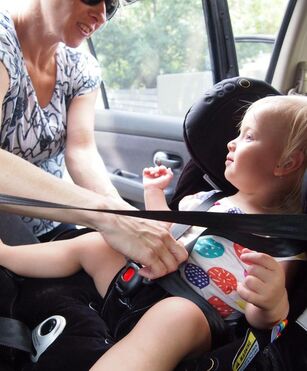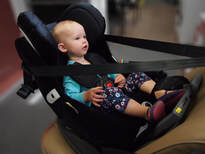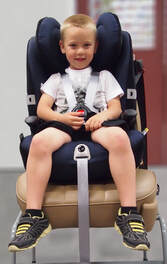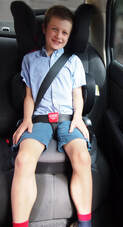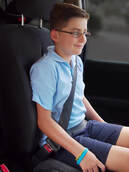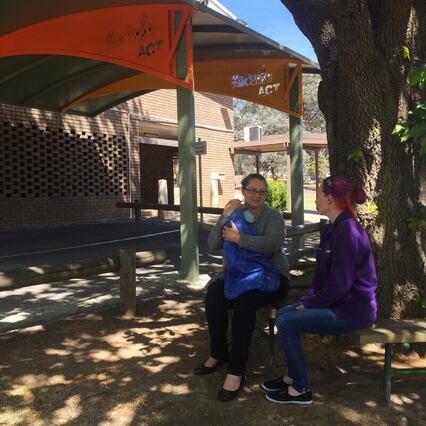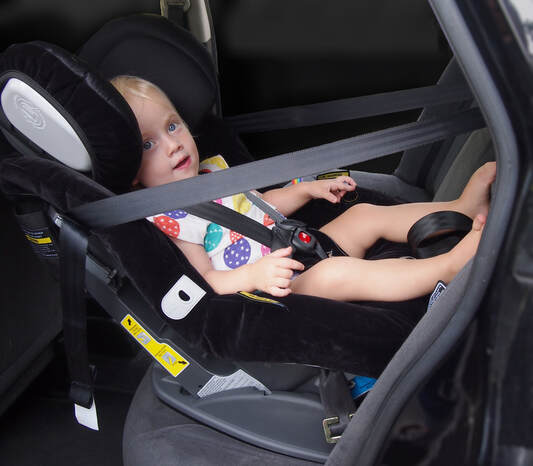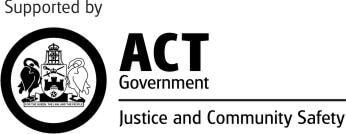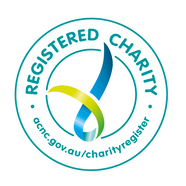CARRYING CHILDREN SAFELY IN CARS
Ages and Stages
|
REAR-FACING
Up to 3-4 years* (Legally - until at least 6 months) It is recommended that children stay rear-facing for as long as possible: until at least 12 months of age and over where possible. Restraint types: Infant carrier, rear-facing 0-4/0-8 years car seat |
FORWARD-FACING
Up to 8+ years* (Legally - until at least 4 years) It is recommended that children stay in an in-built harness for as long as possible. Restraint types: Forward-facing 0-4/0-8 years car seat, forward-facing car seat with in-built harness up to 8 years+*, convertible booster seat with in-built harness |
|
BOOSTER SEAT
Up to 10+ years* (Legally until minimum of 7 years) It is recommended that children stay in a booster seat for as long as possible. Restraint types: Cushion booster**, dickie seat, integrated booster seat, untethered booster, tethered booster, tethered booster to 10 years* all with either a lap/sash seatbelt or with lap-only belt with external/h-harness** |
NO CAR SEAT
10+ years* (Legally from a minimum of 7 years) It is recommended that children do not move to the seat of the car until they no longer fit in a Car Seat or Booster seat and when they meet the 5 step test. |
* All ages are approximate
** Cushion boosters and external harnesses are no longer manufactured, use where available and check that the manufacturers date is less than 10 years old and that the restraint or harness has not been in an accident.
** Cushion boosters and external harnesses are no longer manufactured, use where available and check that the manufacturers date is less than 10 years old and that the restraint or harness has not been in an accident.
COMMON QUESTIONS
What if a baby or child has grown out of their car seat before they are legally ready to move to the next stage?
A wide range of car seats are now available that are designed to accommodate children several years longer than the minimum legal age (eg. car seats that rear-face until 3-4 years of age* when the minimum requirement is 6 months of age). If a child grows out of their current car seat or booster seat before the legal minimum age there should be a larger seat, in the same stage, on the market to buy or hire. If they do not fit in to any restraint on the market they can be moved in to the next stage of restraint (i.e. rear-facing to forward-facing).
Does a child have to be in a car seat in a taxi?
Taxi’s are exempt from a number of car seat related road rules. The legal requirements for taxis are:
These rules also apply to hire cars and minibuses in the ACT, they do not apply to any other services (including ride sharing services). These laws vary state to state.
When can a child sit in the front seat?
This depends on the age of the child and the type of vehicle.
Cars with 2 or more rows of seats (i.e. sedans):
It is illegal to use a booster seat with a lap-only belt for children under 7 years of age, past this age it is legal but not recommended. If a child is under 7 years of age and in a booster seat they will need to also have an external harness/h-harness. Lap-only belt do not offer the same protection as a lap-sash belt in a crash and Kidsafe ACT recommends that no passenger uses them unless there are no other options.
What if a baby or child has grown out of their car seat before they are legally ready to move to the next stage?
A wide range of car seats are now available that are designed to accommodate children several years longer than the minimum legal age (eg. car seats that rear-face until 3-4 years of age* when the minimum requirement is 6 months of age). If a child grows out of their current car seat or booster seat before the legal minimum age there should be a larger seat, in the same stage, on the market to buy or hire. If they do not fit in to any restraint on the market they can be moved in to the next stage of restraint (i.e. rear-facing to forward-facing).
Does a child have to be in a car seat in a taxi?
Taxi’s are exempt from a number of car seat related road rules. The legal requirements for taxis are:
- Children must be in an approved, properly adjusted and fastened child restraint if one is available
- If a car seat is not available a child under 1 years of age can sit in the lap of a passenger who is over 16 years of age, provided they are not in the front row (excluding vehicles with only one row of seats)
- Children 1 - 4 years of age must not be in the front seat (unless the vehicle has only one row of seats)
- Children 4 - 7 years of age must not be in the front seat unless the back row is taken up by children younger than them (unless the vehicle has only one row of seats)
These rules also apply to hire cars and minibuses in the ACT, they do not apply to any other services (including ride sharing services). These laws vary state to state.
When can a child sit in the front seat?
This depends on the age of the child and the type of vehicle.
Cars with 2 or more rows of seats (i.e. sedans):
- 0-4 year olds must never sit in the front seat
- 4-7 year olds must not sit in the front seat unless the back row is taken up by children younger than them. They must also be restrained in an approved, correctly fitted child restraint. This rule also applies if you cannot fit three restraints across the second row of a vehicle
- 7+ year olds can sit in the front seat however it is recommended that children are at least 12 years of age and meet the 5-step test and the front seat should be moved as far back as possible (to be away from the airbag and dash)
- 0-6 month olds must only travel in the front seat if there is no airbag. Rear-facing carriers or car seats must not be used where there is an airbag regardless of the child’s age
- 6 months onwards normal rules apply
It is illegal to use a booster seat with a lap-only belt for children under 7 years of age, past this age it is legal but not recommended. If a child is under 7 years of age and in a booster seat they will need to also have an external harness/h-harness. Lap-only belt do not offer the same protection as a lap-sash belt in a crash and Kidsafe ACT recommends that no passenger uses them unless there are no other options.
GLOSSARY
Rear-facing: A Car Seat that is installed so that the child is reclined and facing the back of the car.
Forward-facing: A Car Seat that is installed so that the child is facing the front of the car and that has an in-built harness.
Booster seat: A restraint that is installed so that child is facing the front of the car and is held in by either a lap-sash seatbelt or a seat belt with an external/h-harness.
Restraint: Is the overall word used to cover rear-face and forward-facing car seats as well as booster seats.
Car Seat: Is the overall word used to cover restraints with an in-built harness (rear-facing and forward-facing).
In-built harness: also known as a 5-point or 6-point harness. This refers to a harness that is built into the car seat during manufacture and can not be fitting to the Car Seat after purchase.
External/h-harness: a harness that is not made as part of the seat and is added on to booster seats or used by themselves (no longer manufactured).
Stage: Refers to the four ways children travel in the car: rear-facing, forward-facing, booster seat and in no restraint
Rear-facing: A Car Seat that is installed so that the child is reclined and facing the back of the car.
Forward-facing: A Car Seat that is installed so that the child is facing the front of the car and that has an in-built harness.
Booster seat: A restraint that is installed so that child is facing the front of the car and is held in by either a lap-sash seatbelt or a seat belt with an external/h-harness.
Restraint: Is the overall word used to cover rear-face and forward-facing car seats as well as booster seats.
Car Seat: Is the overall word used to cover restraints with an in-built harness (rear-facing and forward-facing).
In-built harness: also known as a 5-point or 6-point harness. This refers to a harness that is built into the car seat during manufacture and can not be fitting to the Car Seat after purchase.
External/h-harness: a harness that is not made as part of the seat and is added on to booster seats or used by themselves (no longer manufactured).
Stage: Refers to the four ways children travel in the car: rear-facing, forward-facing, booster seat and in no restraint

